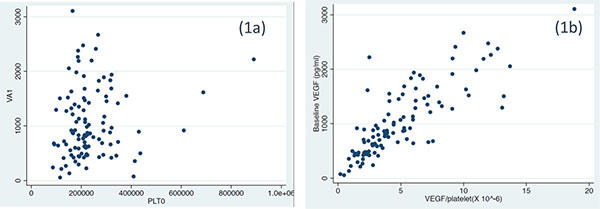|
|
|
Indian Pediatr 2020;57:
1188-1189 |
 |
Platelet Normalized Serum Vascular Endothelial Growth Factor
Levels in Progressive Pediatric Solid Malignancies: Authors'
Reply
|
|
Raja Pramanik and Sameer Bakhshi*
Department of Medical Oncology, All India Institute of
Medical Sciences, New Delhi, India.
Email:
[email protected]
|
|
We appreciate the comments and suggestions by the
reader. Available literature shows that there is a controversy regarding
the best blood compartment and the best test to measure VEGF in cancer
patients. VEGF in cancer patients is the sum total of platelet derived
VEGF as well as other sources like neo-angiogenesis in the tumor tissue.
One of the studies showed that the best discrimination between healthy
volunteers and cancer patients was observed in platelet poor plasma
(PPP). As gene-rating plasma induces platelet activation with consequent
VEGF release from platelets, citrate-theophylline-adenosine-dipyridamole
plasma was suggested by some authors to evaluate VEGF [1]. Serum
VEGF is more practical because VEGF levels in citrated plasma are low
and lie close to the limits of ELISA sensitivity. Some studies have
shown that a standardized measurement of serum VEGF, normalized by the
patientís platelet count, which gives a value of serum VEGF per
platelet, can be a useful parameter [2].
We had our baseline platelet counts for all the
patients but the corresponding platelet counts for subsequent follow up
(A2 and A3) assessments were not available for all patients [3]. Hence,
we restricted our analysis to baseline values only. On applying pair
wise correlation to the baseline platelet count and serum VEGF, we found
an insignificant correlation; r=0.16 (P=0.09) (Fig. 1a).
Baseline serum VEGF showed a significant positive correlation with
baseline VEGF per platelet (r=0.81, P<0.0001) (Fig. 1b).
As the serum VEGF and VEGF/per platelet correlate significantly, both
are likely to follow similar trends; this implies that we are likely to
have similar observations, whether we use serum VEGF or VEGF/platelet.
 |
|
Fig. 1 Scatter plots showing
correlation between (a) baseline VEGF and baseline platelet
counts, and (b) baseline VEGF and baseline VEGF per platelet.
|
Similar observations were reported by Vermeulen,
et al. [4]; they commented that in view of the lack of a strong
association between serum VEGF and platelet count, and the association
of serum VEGF with the degree of stimulation of endothelial cell
proliferation in vitro, measuring serum VEGF might be more suitable in
cancer patients than measuring plasma VEGF. Also, it has been postulated
that at least part of the VEGF in platelets represents that endocytosed
from the plasma due to their scavenging effect [4]. So, measuring the
entire collection (serum VEGF) may not be less appropriate.
Further, most previous studies on metronomic
chemo-therapy had measured serum VEGF and we intended to be consistent
and comparable to them [5,6]. Hence, our conclusion remains the same
that VEGF is not a reliable biomarker for metronomic chemotherapy, but
the best test for VEGF still remains an illusion.
REFERENCES
1. Wynendaele W, Derua R, Hoylaerts MF, et al.
Vascular endothelial growth factor measured in platelet poor plasma
allows optimal separation between cancer patients and volunteers: A key
to study an angiogenic marker in vivo? Ann Oncol. 1999;10:965-71.
2. George ML, Eccles SA, Tutton MG, Abulafi AM, Swift
RI. Correlation of plasma and serum vascular endothelial growth factor
levels with platelet count in colorectal cancer: Clinical evidence of
platelet scavenging? Clin Cancer Res. 2000;6:3147-152.
3. Pramanik R, Tyagi A, Agarwala S, Vishnubhatla S,
Dhawan D, Bakhshi S. Evaluation of vascular endothelial growth factor
(VEGF) and thrombospondin-1 as bio-markers of metronomic chemotherapy in
progressive pediatric solid malignancies. Indian Pediatr. 2020;
57:508-11.
4. Vermeulen PB, Salven P, Benoy I, Gasparini G,
Dirix LY. Blood platelets and serum VEGF in cancer patients. Br J
Cancer. 1999;79:370-73.
5. Kesari S, Schiff D, Doherty L, et al. Phase
II study of metronomic chemotherapy for recurrent malignant gliomas in
adults. Neuro Oncol. 2007;9:354-63.
6. Kieran MW, Turner CD, Rubin JB, et al. A feasibility trial
of antiangiogenic (metronomic) chemotherapy in pediatric patients with
recurrent or progressive cancer. J Pediatr Hematol Oncol.
2005;27;573-81.
|
|
|
 |
|

